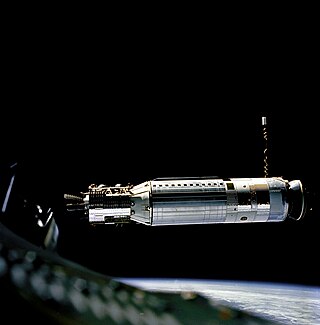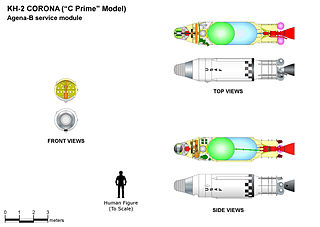
The RM-81 Agena was an American rocket upper stage and satellite bus which was developed by Lockheed Corporation initially for the canceled WS-117L reconnaissance satellite program. Following the division of WS-117L into SAMOS and Corona for image intelligence, and MIDAS for early warning, the Agena was later used as an upper stage, and an integrated component, for several programs, including Corona reconnaissance satellites and the Agena Target Vehicle used to demonstrate rendezvous and docking during Project Gemini. It was used as an upper stage on the Atlas, Thor, Thorad and Titan IIIB rockets, and considered for others including the Space Shuttle and Atlas V. A total of 365 Agena rockets were launched between February 28, 1959 and February 1987. Only 33 Agenas carried NASA payloads and the vast majority were for DoD programs.

Project Echo was the first passive communications satellite experiment. Each of the two American spacecraft, launched in 1960 and 1964, were metalized balloon satellites acting as passive reflectors of microwave signals. Communication signals were transmitted from one location on Earth and bounced off the surface of the satellite to another Earth location.

Satellite geodesy is geodesy by means of artificial satellites—the measurement of the form and dimensions of Earth, the location of objects on its surface and the figure of the Earth's gravity field by means of artificial satellite techniques. It belongs to the broader field of space geodesy. Traditional astronomical geodesy is not commonly considered a part of satellite geodesy, although there is considerable overlap between the techniques.

A balloon satellite, sometimes referred to as a "satelloon", is a satellite inflated with gas after it has been put into orbit.

Thor-Agena was a series of orbital launch vehicles. The launch vehicles used the Douglas-built Thor first stage and the Lockheed-built Agena second stages. They are thus cousins of the more-famous Thor-Deltas, which founded the Delta rocket family. The first attempted launch of a Thor-Agena was in January 1959. The first successful launch was on 28 February 1959, launching Discoverer 1. It was the first two-stage launch vehicle to place a satellite into orbit.
Discoverer 30, also known as Corona 9022, was an American optical reconnaissance satellite which was launched in 1961. It was a KH-3 Corona''' satellite, based on an Agena-B rocket.
Kosmos 76, also known as DS-P1-Yu No.3 was a Soviet satellite which was used as a radar calibration target for tests of anti-ballistic missiles. It was built by the Yuzhnoye Design Bureau, and launched in 1965 as part of the Dnepropetrovsk Sputnik programme.
Kosmos 101, also known as DS-P1-Yu No.4 was a Soviet satellite which was used as a radar calibration target for tests of anti-ballistic missiles. It was built by the Yuzhnoye Design Bureau, and launched in 1965 as part of the Dnepropetrovsk Sputnik programme.

Kosmos 135, also known as DS-U2-MP No.1, was a Soviet satellite which was launched in 1966 as part of the Dnepropetrovsk Sputnik programme. It was a 355 kilograms (783 lb) spacecraft, which was built by the Yuzhnoye Design Office, and was used to investigate micrometeoroids and particles of dust in space.
Kosmos 137, also known as DS-U2-D No.1, was a Soviet satellite which was launched in 1966 as part of the Dnepropetrovsk Sputnik programme. It was a 295 kilograms (650 lb) spacecraft, which was built by the Yuzhnoye Design Bureau, and was used to investigate charged particles in the Earth's magnetosphere.
OPS 3762, also known as FTV-2355, was an American reconnaissance satellite which was launched in 1964. It was the first radar imaging satellite to be launched, and the only Quill spacecraft to fly. Its mission was to demonstrate radar imaging techniques for future missions. However, the programme was cancelled before any more satellites were launched.
Discoverer 24, also known as Corona 9018A, was an American area survey optical reconnaissance satellite which was launched in 1961 but failed to achieve orbit. It was a KH-5 Argon satellite, based on an Agena-B. It was the third KH-5 to be launched.
FTV-1126, also known as Corona 9034A, was an American area survey optical reconnaissance satellite launched in 1962. It was a KH-5 Argon satellite, based on an Agena-B. It was also unofficially known as Discoverer 41, a continuation of the designation sequence used for previous US reconnaissance satellites, which had officially been discontinued after Discoverer 38. It was the first KH-5 satellite to complete its mission successfully.
FTV-1132, also known as the Corona 9042A, was an American area survey optical reconnaissance satellite which was launched in 1962. It was a KH-5 Argon satellite, based on an Agena-B. The satellite operated successfully, but its film capsule was lost during recovery due to a parachute failure.

Discoverer 26, also known as Corona 9019, was an American optical reconnaissance satellite which was launched in 1961. It was the sixth of ten Corona KH-2 satellites, based on the Agena-B.

Discoverer 18, also known as Corona 9013, was an American optical reconnaissance satellite launched on 7 December 1960 at 20:24:00 GMT. It was the first successful, and the third of ten total Corona KH-2 satellites, based on the Agena-B.
Discoverer 29, also known as Corona 9023, was an American optical reconnaissance satellite which was launched in 1961. It was the first KH-3 Corona''' satellite, which was based on an Agena-B rocket.
Discoverer 31, also known as Corona 9024, was an American optical reconnaissance satellite which was launched in 1961. It was a KH-3 Corona''' satellite, based on an Agena-B.
Discoverer 32, also known as Corona 9025, was an American optical reconnaissance satellite which was launched in 1961. It was a KH-3 Corona''' satellite, based on an Agena-B.
Discoverer 36, also known as Corona 9029, was an American optical reconnaissance satellite which was launched in 1961. It was a KH-3 Corona satellite, based on an Agena-B rocket. It was the penultimate KH-3 satellite to be launched, the last successful mission, and the most successful of the program.








